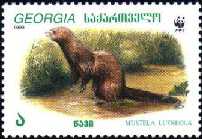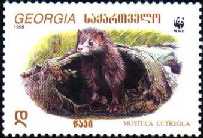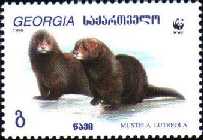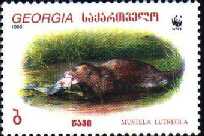Previous Years
1999 Issues
248 - Greenland
249 - Niue
250 - Ascension Islands
251 - Barbados
252 - Benin
253 - Croatia
254-255 - Kyrgyzstan
256 - Georgia
257 - Tristan da Kuhna
258 - Central Africa
259 - Angola
260 - Madagaskar
261 - Haiti
262 - India
263 - Hong Kong
264 - Montserrat
2000 Issues
2001 Issues
2002 Issues
Last updated on
November-15-2002
The common name mink comes from the Swedish word maenk. Mink are members
of the weasel family which includes skunks, otters, fishers, martens
and wolverines.
The mink's coloration varies from brown to almost black, its belly
is slightly lighter than its back and flanks, and it may have a white chin
and throat. A domestic mink raised on a ranch for the fur industry is normally
much larger than a wild mink and the color of its fur ranges from white
to black with everal unique colors that have been developed by mink ranchers.
A mink's pelt has thick underfur for insulation and buoyancy because the
animal lives in and near water. However, it does not have webbed feet or
a specialized tail as do other semi-aquatic mammals such as beaver, muskrats
and otters.
Mink are found thoughout North America, northern Europe and the ex-USSR.
The mink lives in a variety of wetland and riparian habitats including
rivers, streams, lakes, ponds and marshes. Permanent water, a reliable
food source and adequate shoreline vegetation are keys to good mink habitat
Upland vegetation around the stream or wetland is also important to the
mink, because it frequently hunts as much as one-quarter mile away from
the water. Intensive farming or grazing to the edge of the shoreline or
stream bank reduces the quality of mink habitat because it eliminates necessary
hunting sites. Stream channelization reduces the amount of habitat available
by reducing the length of the stream, and erosion reduces the quality of
habitat for fish and other prey. Another way in which mink habitat is commonly
destroyed is by people draining and filling wetlands, or allowing too much
grazing of wetlands. The average lifespan of a mink is less than one year
and it is uncommon for them to live as long as four years. Mink are preyed
upon by owls, coyotes and cats. Other significant sources of mortality
include fighting with other minks, starvation of dispersing juveniles,
and trapping.




Animal Mustela lutreola
Issue date: April,27 1999
Values: 10,20,30,60 T.
Prinitng: 250 000 (incl. 125 000 in mini-sheets
Printed in: sheets of 25 (5x5) &
mini-sheets of 5 sets
Artwork: O.Bell & B.Koblianidze
Georgian Stamps - On-line Catalogue Of Georgian post stamps
Minks - Animal.info
Collector's Corner
 ABOUT
THE HISTORY OF WWF LOGO
ABOUT
THE HISTORY OF WWF LOGO